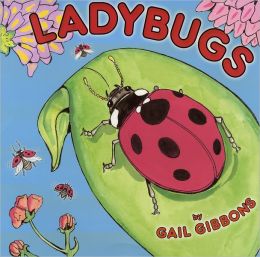Ladybugs
Writtten and illustrated by Gail Gibbons
In her book Ladybugs, prolific author Gail Gibbons has crafted yet another solidly informative book for young readers. As in her other non-fiction books, Gibbons captures the interest of children reading at the third grade level by providing basic information young readers seek.
Gibbons illustrates the basic anatomy of a ladybug and shows how it compares to other insects. She also invites readers to look more closely at ladybugs by introducing text and visual information about the many different kinds of ladybugs. A map helps readers see where ladybugs live.
In the section about the life stages of a ladybug, Gibbons shows what juvenile ladybugs look like (as different from an adult as a caterpillar is from a butterfly!). Some readers who have seen the mysterious little “alligators” around may find this section particularly enlightening. Gibbons also discusses the eating habits of ladybugs at all stages of their life cycle.
In Ladybugs the reader also learns some of the interesting adaptations these shiny red insects have developed in order to protect themselves from other insects and birds that might want to eat them. If their bright color doesn’t deter animals from eating them, ladybugs sometimes play dead in the hopes that the attacker might leave them alone. These charming little insects also ooze a stinky fluid from their joints (blech!), which discourages attackers and is the source of the unpleasant ladybug smell some young readers may have noticed.
Perhaps keeping in mind that many people are uncomfortable around insects, even ladybugs, Gibbons points out that ladybugs have been helpful to people at various points in history. Small though they are, these insects are able to consume large quantities of other, destructive insects—such as aphids—so effectively that farmers and gardeners buy them intentionally, hoping the ladybugs will enable them to use fewer pesticides.
With its cheerful, brightly colored illustrations, Ladybugs is likely to engage young readers and would be a terrific addition to a non-fiction reading list. The final page in the book includes additional interesting facts about these insects, and also lists a website for more information.
Websites:
Basic ladybug information: http://animals.nationalgeographic.com/animals/bugs/ladybug/
And more: http://www.sandiegozoo.org/animalbytes/t-ladybug.html
Lost Ladybug—citizen science project: http://www.lostladybug.org/participate.php

